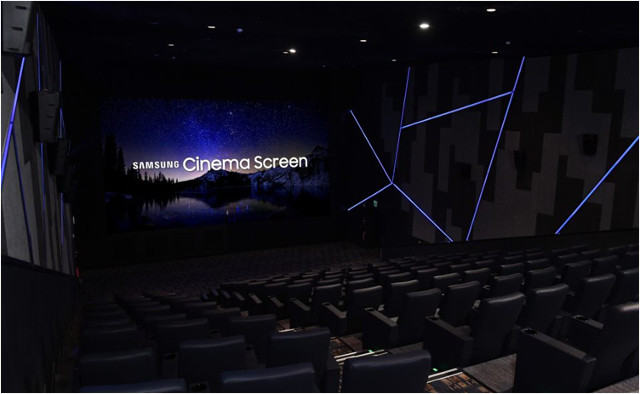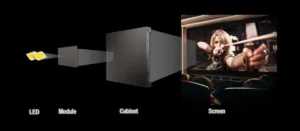Last week, the first commercial DCI-compliant theater screen opened using LED instead of projection technology. The LED screens were supplied by Samsung for the high-end Lotte Cinema World Tower complex in Seoul. A 2K DCI-compliant version of the new Spiderman movie was shown on this 4K resolution screen, but we don’t believe it was mastered differently to take advantage of the high dynamic range offered by this screen –not yet anyway.

This is an historic event. Only last March, at CinemaCon, Samsung stunned the cinema community with private showings of their new LED “CinemaScreen” technology in a specially outfitted theater. I was there to see this and was blown away by the image quality and what this means for the cinema industry – a new technology is here to compete with projection in cinema – something that has never been possible before.
The new commercial version of the CinemaScreen at the Lotte multiplex is being branded as a “Super S theater”, which Wonchun Cha, Lotte Cinema CEO, termed “a new paradigm of movie screening.”

Let’s review the specs of this screen. The pixel pitch is 2.5mm, which, at the minimum viewing distance of 5m, means visual acuity of 20:20. Peak luminance is 146 FL (500 cd/m²) which gives a lot of headroom above the standard theatrical luminance of 14FL (48 cd/m²) and even the Dolby Cinema luminance level of 31 FL (100 cd/m²). That headroom enables the screen to be used in lights-on applications like eSports or concerts in the theater, if desired.
The CinemaScreen features High Dynamic Range (HDR) capability. The contrast ratio is said to be infinity, which assumes that the measurement is taken when there is no signal to a black part of the screen. However, for OLED panels, the International Committee on Display Metrology (ICDM) recommends not using this infinity value, but instead, measure the black level at the lowest signal black level.
At the recent QLED & HDR10 Summit in Los Angeles, Samsung’s Chris Buchanan gave a presentation and answered a lot of audience questions on the new CinemaScreen. He divulged that the black level of the screen is 0.005 cd/m² giving an effective dynamic range of 100,000:1.
The full extent of the color gamut was not specified, but it does support the full DCI-P3 color gamut – possibly all the way up to 500 cd/m² for a huge color volume! Lifetime is said to be 100K hours to 50% of luminance, which means many years of operation.
Samsung has added significant anti-reflection coatings to make the screen incredibly black – even with a light shining on it, we were told. There is also a protective coating to minimize any impacts from objects – whether intentionally or inadvertently landing on the screen.
The viewing angle is specified as 130º horizontally by 65º vertically with uniformity of 95%. Frame rates up to 60 fps are supported (refresh rate is 1920Hz).
Currently, there is no support for stereoscopic 3D, but two viable options exist. One would be to place polarizers with opposite polarization on alternative lines or columns for use with passive glasses, but this will compromise resolution (although Ray Soneira’s tests of LG’s passive LCDs showed that the loss of resolution is not what you would think – Man. Ed.). The other is active shutter glasses but these are not as popular. Buchanan said that both are being evaluated now and a solution will be chosen soon.
The Integrated Media Block (IMB), which holds the encoded and encrypted content, was developed by GDC, a strong IMB supplier in the cinema industry already. The entire combination actually passed DCI certification recently too – the first time a non-projection type display has passed. GDC is also working to roll out an 8K version of this solution, starting in the Chineae market.
Finally, there is the issue of audio. Most cinemas feature a perforated screen so the center channels can be mounted in back of the screen. This is not possible with the CinemaScreen so the speakers are mounted around the screen. While not ideal, proprietary “de-elevation processing” is used with JBL’s “Sculptured Surround Sound” solution so that the sound appears to be coming from the screen center. Samsung’s Audio Lab and the newly acquired JBL team from Harman developed this solution, noted Buchanan.
Physically, there are 96 cabinets in the 4K (4096 x 2160) screen with each cabinet comprised of 24 modules. That means a screen that is 33.8 feet (10.3m) wide.
Buchanan also discussed some of the efforts Samsung has been undertaking to engage with industry regarding this new screen technology. For example, the firm has worked extensively with 20th Century Fox and Universal Pictures to test and improve the CinemaScreen solution. This includes testing for color accuracy, digital artifacts, contrast and brightness. More than 15 films have been evaluated on the screen so far, which has helped to establish a standard brightness level and best practices for tone mapping from 1000 cd/m² HDR home entertainment mastered content.
All of the major Hollywood studio executives have seen demos, as well as key exhibitors including IMax, Cinemark and Bowtie. There is even a specially-graded clip from “The Great Wall” that showcases the capabilities of the display (this was shown at CinemaCon and looked incredible).
But before the debut in the Lotte theater, only around 500 people in the world had seen a full-fledged demo of the CinemaScreen. Now, anyone can see it.
In the works are two installs in the Los Angeles area: a 4K commercial theater and a 2K screen for a post production house. These should be in place by this fall.
Samsung has ignited a flurry of activity among its competitors as well. You can bet that Sony has now accelerated the theatrical development of their LED CLEDIS screen and Silicon Core has a new LED screen module designed for theatrical and other low light level applications (which they will describe at the next Display Summit). And you can bet that the projector makers will react with something as well. It’s an exciting time in the cinema space. – CC

